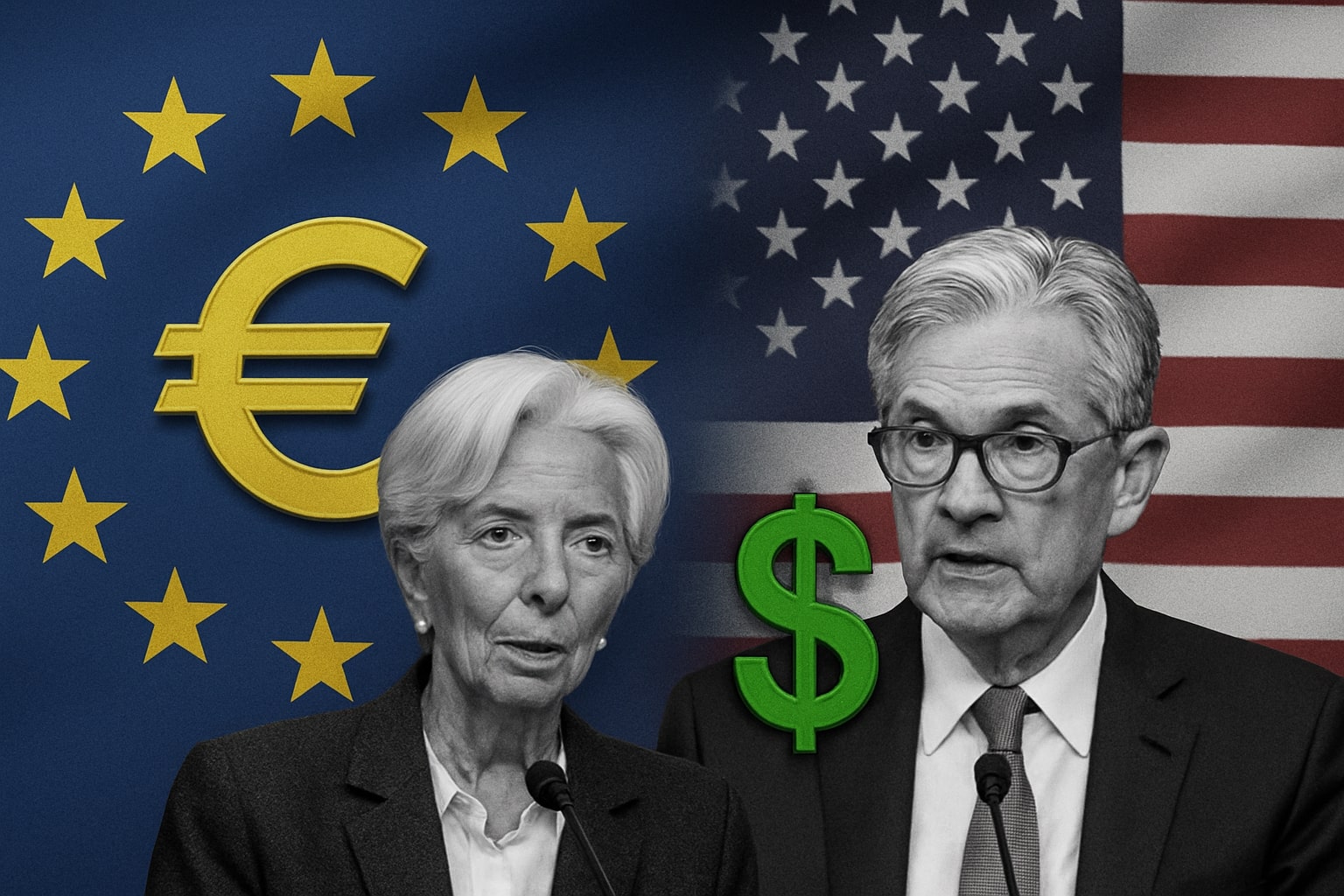
EUR/USD Price Forecast: Euro Holds 1.1574 as Fed Easing Bets Build and Traders Eye Break Above 1.1600
The Euro steadies near 1.1574 against the US Dollar after soft labor data fuels December Fed cut expectations while traders await the US House shutdown vote | That's TradingNEWS
EUR/USD Price Forecast: Euro Holds 1.1574 as Fed Easing Bets Clash With Labor Market Weakness
The Euro to U.S. Dollar (EUR/USD) pair traded around 1.1574 on Wednesday, slipping 0.11% intraday as traders weighed weak U.S. employment figures against growing expectations for a Federal Reserve rate cut in December. Despite intraday losses, EUR/USD remains up 0.63% week-on-week, showing resilience near the upper bound of its recent 1.1500–1.1600 trading corridor.
This equilibrium reflects a battle between diverging fundamentals — a weakening U.S. economy driving dollar softness, and a Eurozone still struggling with stagnation and muted inflation.
Labor Market Deceleration Strengthens the Case for Fed Easing
Dollar volatility intensified after the ADP private payroll report revealed consistent job losses averaging 11,000 per week in October, raising alarms about employment durability. Investors now assign a 63% probability to a 25-basis-point Fed cut at the December meeting, according to futures data.
However, the lack of official Non-Farm Payrolls (NFP) figures, frozen by the 43-day U.S. government shutdown, has left markets navigating blind. The missing data has elevated sensitivity to second-tier releases, amplifying USD fluctuations around 1.1550–1.1610.
With New York Fed President John Williams hinting at potential balance-sheet expansion and the Federal Reserve’s confirmation that quantitative tightening is near its end, traders are repricing dollar risk. Treasury yields retreated, pushing the 2-year note to 3.92%, its lowest in 18 months — a structural headwind for the greenback.
Eurozone Data Fails to Inspire: German ZEW and CPI Flatline
The Eurozone’s largest economy continues to lag. Germany’s harmonized CPI rose only 0.3% month-on-month in October, bringing annual inflation down to 2.3%, its lowest since early 2022. While stable prices remove pressure from the European Central Bank (ECB) to tighten further, they also signal waning consumer demand.
At the same time, the German ZEW investor confidence index dipped from 39.3 to 38.5, signaling fading optimism about near-term recovery. Danske Bank analysts described the report as “a reminder that Europe’s growth engine remains in neutral,” noting that energy-sensitive industries continue to drag manufacturing sentiment.
These readings weakened euro buying momentum even as global equities rallied on U.S. fiscal optimism. The market reaction underscores how EUR/USD strength is driven more by dollar weakness than by renewed faith in European fundamentals.
Technical Picture: EUR/USD Faces Stiff Resistance Near 1.1600–1.1680
Technically, EUR/USD remains pinned between two decisive boundaries. Immediate support lies at 1.1520–1.1530, the level that twice halted declines in late October, while resistance forms at 1.1600–1.1686, where sellers have repeatedly re-emerged since mid-September.
The Relative Strength Index (RSI) stands near 48, indicating neutral momentum. The MACD lines have flattened, awaiting a breakout trigger. On the 4-hour chart, a potential falling wedge formation hints at an impending expansion in volatility.
If bulls manage a close above 1.1668, the door opens for a retest of 1.1748, which aligns with the 76.4% Fibonacci retracement of the 2021–2022 decline. Conversely, failure to defend 1.1500 risks a downward acceleration toward 1.1460, and potentially 1.1400, marking the next psychological floor.
Market Structure and Cross-Asset Context
Risk sentiment has oscillated with the shutdown vote, which investors expect will pass this week and reopen key government agencies. The resulting data backlog, including the delayed September jobs report, could drive violent repricing across the dollar complex.
Meanwhile, U.S. equity indices continue diverging — the Dow Jones surged past 48,000, while the Nasdaq Composite slipped 0.5%, reflecting a rotation from tech to defensives. This divergence has historically pressured USD as traders rebalance portfolios toward euro assets.
The euro’s year-to-date gain of roughly 9% reflects this macro repricing more than intrinsic strength. Central banks — particularly the ECB — remain cautious, with President Christine Lagarde emphasizing that rate cuts are “not on the near-term agenda,” keeping real yield differentials in flux.
Read More
-
AMD Stock Price Forecast - AMD Shares Soars to $258.32 as AI and Data Center Demand Fuel a Major Breakout
12.11.2025 · TradingNEWS ArchiveStocks
-
XRP Price Forecast - XRP-USD Struggles at $2.35 as Bulls Defend $2.00 Support and Death Cross Threatens a Deeper Pullback
12.11.2025 · TradingNEWS ArchiveCrypto
-
Oil Price Forecast - Oil Prices Fall Sharply; WTI at $58.97, Brent at $63.01 as OPEC Forecast Sparks Bearish Turn
12.11.2025 · TradingNEWS ArchiveCommodities
-
Stock Market Today: Dow Breaks 48,000 as AMD Surges 9% and JPMorgan Hits Record High
12.11.2025 · TradingNEWS ArchiveMarkets
-
GBP/USD Price Forecast - Pound Slides to 1.3105 as BoE Rate-Cut Odds Surge and UK Political Turmoil Pressures the Pound
12.11.2025 · TradingNEWS ArchiveForex
Fed Commentary and Dollar Path Dependency
All eyes now turn to the Federal Open Market Committee (FOMC) rhetoric. A dovish bias from officials such as Williams or Bostic could weaken the dollar further, pushing EUR/USD toward 1.1700.
However, if Fed speakers reassert commitment to data dependency, or if delayed NFPs show stronger-than-expected payroll growth, the pair may reverse sharply toward 1.1520. In such a case, the USD Index (DXY) could rebound above 103, pressuring the euro back into the lower 1.15 handle.
Medium-Term Outlook: Rangebound but Leaning Bullish
From a medium-term standpoint, the currency pair remains locked in a neutral-to-bullish pattern. The structural backdrop — slowing U.S. growth, flattening inflation in Europe, and expectations for monetary easing in both economies by Q1 2026 — implies extended range trading between 1.1500 and 1.1700 through year-end.
However, momentum indicators lean slightly to the upside. If the shutdown resolution and soft jobs data combine to depress Treasury yields further, EUR/USD could break 1.1700, targeting 1.1780, followed by 1.1900, where multi-month resistance resides.
Strategic View and Rating
Based on the current configuration — fundamental divergence favoring euro stability, Fed dovish pivot, and a technical structure nearing breakout — EUR/USD warrants a Buy rating for traders anticipating a move toward 1.17–1.18 over the next 2–3 weeks.
Short-term pullbacks into 1.1520–1.1540 are opportunities for accumulation, provided that U.S. data remains soft and the ECB maintains its non-intervention stance.
In essence, the euro’s fate remains tethered to Washington’s fiscal clarity and the Federal Reserve’s willingness to loosen conditions. The technical map favors bulls — but the next U.S. labor release will determine whether EUR/USD remains rangebound or embarks on a new uptrend.


















